Fast Facts
Location: Chittorgarh, Rajasthan
Built By: Chitrangada Mori
Occupants: Mauryas of Chittor, Guhilas of Medapata, Sisodias of Mewar
Area: 691.9 acres
Current Status: The fort has been declared as UNESCO World Heritage Site
Visiting Time: 9:45AM - 6:30PM
Important Structures: Vijay Stambh, Kirti Stambh, Gaumukh Reservoir, Rana Kumbha Palace, Padmini Palace, Meera Mandir, Kalikamata Mandir, Fateh Prakash Palace, Jain Mandir
Seven Gates of the Fort: Padan Pol, Bhairon Pol, Hanuman Pol, Jorla Pol, Ganesh Pol, Laxman Pol, Ram Pol
Chittorgarh Fort is regarded as the symbol of Rajput chivalry, resistance and bravery. The fort is situated 175 kilometer to the east of Udaipur and is believed to be named after the person who built it, Chitrangada Mori. The famous Chittorgarh fort, which is one of the largest in India, is situated on a 180 meter high hill that rises from the banks of river Berach. The fort is known for its seven gates namely Padan Gate, Ganesh Gate, Hanuman Gate, Bhairon Gate, Jodla Gate, Lakshman Gate and the main gate which is named after Lord Ram. The Chittorgarh fort houses many palaces, like the Rana Kumbha Palace, the Fateh Prakash Palace, the Tower of Victory and Rani Padmini's Palace. All these structures are significant for their Rajput architectural features. There are also many temples within the fort. A huge complex of Jain temples are a major attraction. Chittorgarh fort, along with other hill forts of Rajasthan was declared as UNESCO World Heritage Site in 2013.
History of the Fort
In ancient India, the place where the fort is currently present was known as Chitrakut. Due to the ancientness of this fort, there are no clear evidences supporting the origin of the fort. There is however, a bunch of theories that are still subjected to debates. The most common theory states that Chitrangada Mori, a local Maurya ruler built the fort. A water body which was situated next to the fort is said to have been created by the legendary hero of Mahabharata, Bhima. The legend has it that Bhima once struck the ground with all his might, which gave rise to a huge reservoir. Bhimlat Kund, an artificial tank next to the fort, was where the legendary reservoir once sat, it is said.
Thanks to the fort’s majestic appearance, many rulers in the past have tried to capture it, in an attempt to make it their own. Bappa Rawal of the Guhila dynasty was one of the earliest rulers to have captured the fort successfully. It is said that the fort was captured by him around 730 AD, after defeating the Moris, to whom the fort once belonged. Another version of the story states that Bappa Rawal did not capture the fort from the Moris but from the Arabs, who had captured it from the Moris, even before the arrival of Bappa Rawal. It is said that Bappa Rawal was part of the army led by Nagabhata I of the Gurjara Pratihara dynasty. It is believed that this army was mighty enough to defeat the famous troops of Arab, who were considered imperious on a battle field back then. Another legend has it that the fort was given as part of dowry to Bappa Rawal by the Moris, when they gave the hand of one of their princesses in marriage to Bappa Rawal.
The Conquest of Alauddin Khilji
The fort remained with the rulers of the Guhila dynasty for a long period of time until 1303, when the ruler of Delhi Sultanate Alauddin Khilji decided to capture it. He took over the ownership of the fort from King Ratnasimha after a siege that lasted for about eight months. This conquest is associated with massacre and bloodshed as many believe that Alauddin Khilji ordered the execution of more than 30,000 Hindus after capturing the fort. Another famous legend states that the fort was captured by Khilji in an attempt to force Padmini, the queen of Ratnasimha, into an extra marital relationship. This motive of Khiljiis said to have resulted in the mass self-immolation (jauhar) of Chittorgarh women, led by Queen Padmini. A few years later, Alauddin Khilji passed on the fort to his son Khizr Khan, who possessed it until 1311 AD.
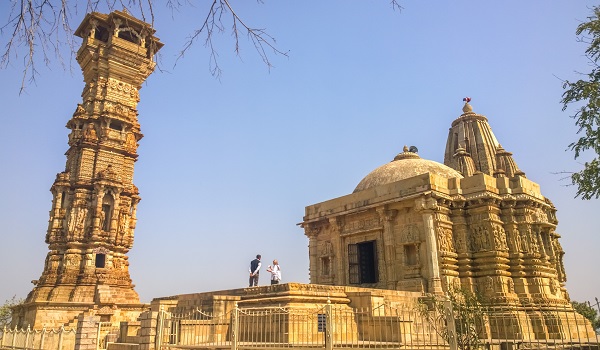
Change of Ownerships
Unable to withstand the continuous persuasion by the Rajputs, Khizr Khan gave up the fort to the Sonigra chief Maldeva. This ruler held the possession of the fort for the next seven years before Hammir Singh of the Mewar dynasty decided to snatch it away from him. Hammir then came up with a plan to deceive Maldeva and finally managed to capture the fort. Hammir Singh is credited with turning the Mewar dynasty into a military machine. Hence, the descendants of Hammir enjoyed the luxuries offered by the fort for years. One such famous descendant of Hammir who came to the throne in 1433 AD was Rana Kumbha. Though the Mewar dynasty flourished into a stronger military force under the reign of Rana, plans to capture the fort by various other rulers were in full swing. Unexpectedly, his death was caused by his own son Rana Udaysimha, who killed his father to ascend the throne. This was perhaps the beginning of the end of the famous Mewar dynasty. On March 16 1527, one of the descendants of Rana Udaysimha was defeated in a battle by Babar and the Mewar dynasty grew weaker. Using this as an opportunity, Bahadur Shah of Muzaffarid dynasty sieged the fort in 1535. Once again, there were loss of lives through massacre and jauhar.
Akbar’s Invasion
In 1567, Emperor Akbar, who wanted to capture the whole of India, set his eyes on the famous Chittorgarh fort. During this time, the place was being ruled by Rana Uday Singh II of the Mewar dynasty. Akbar had a massive army and hence most of the rulers of India were accepting defeat even before trying out Akbar’s strong army on the battle field. Few brave kings like Rana of Mewar had shown resistance to Akbar’s demands. This led to a war between the Mughal emperor and the army of Mewar. After a gory battle which lasted for months, Akbar defeated Rana Uday Singh II’s army and took over the ownership of Chittorgarh and with it the fort. The fort then remained with the Mughals for a long period of time.
Layout of the Fort
The fort, when viewed from above, looks roughly like a fish. Spread across an area of 700 acres, the circumference of the fort alone covers an area of 13 kilometers. There are seven massive gates, safeguarding all the entrances. The main gate is called as Ram Gate. The fort has 65 structures including temples, palaces, memorials and water bodies. There are two prominent towers within the premises of the fort namely Vijay Stambha (Tower of Victory) and Kirti Stambha (Tower of Fame).
Vijay Stambha was built by Rana Kumbha in 1448 to celebrate his victory over Mahmud Shah I Khalji. The tower is dedicated to Lord Vishnu. The slabs in the uppermost part of the tower contain a detailed genealogy of the rulers of Chittor and their deeds. The fifth floor of the tower contains the names of the architect, Sutradhar Jaita, and his three sons who helped him build the tower. The remarkable religious pluralism and tolerance practised by the Rajputs is clearly visible in the victory tower. The Jain Goddess Padmavati sits at the topmost storey, while the third storey and the eighth storey have the word Allah carved in Arabic.

Image Source: Wikimedia.org
Kirti Stambha was erected by Bagherwal Jain in the 12th century to honor Adinath, the first Jain tirthankar. It was built during the reign of Rawal Kumar Singh (c. 1179-1191). The tower is 22 metre high.
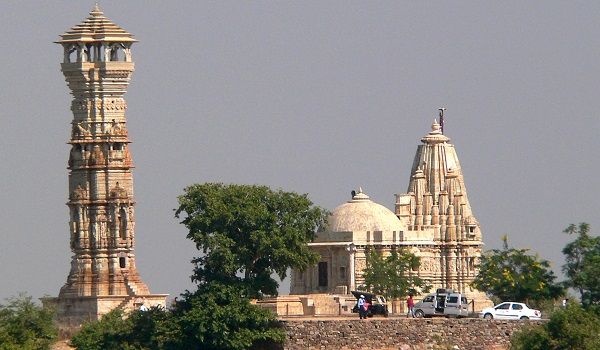
Next to Vijay Stambha stands the famous Rana Kumbha's palace, which is now in ruins. The palace once served as the main residence of Rana Kumbha and is one of the oldest edifices within the fort.

Image Source: Wikimedia.org
Next to the palace of Rana Kumbha stands the Fateh Prakash Palace, built by Rana Fateh Singh. There are also modern halls and a museum located next to these impressive palaces. It was built in the Rajput style of architecture , and the has a vast collection of wood crafts, post medieval statues of Jain Ambica and Indra, weapons like axes, knives and shields, terracotta statues of local tribal people, paintings, and crystal ware.
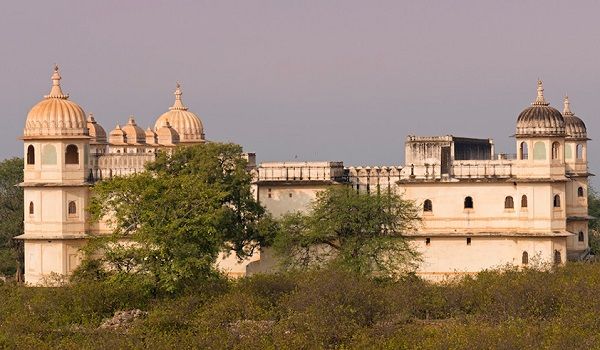
Next to the Kirti Stambha stands a temple dedicated to the poetess-saint Meera.
In the southern part stands the majestic three storied structure, Rani Padmini’s palace.

Image Source: tourism.rajasthan.gov.in
A few meters away from Padmini’s palace, is where the famous Kalika Mata Temple is located. Initially a temple dedicated to the Sun God, it was reconstructed to house Goddess Kali. Towards the western side of the fort, stands another temple dedicated to Goddess Tulja Bhavani.
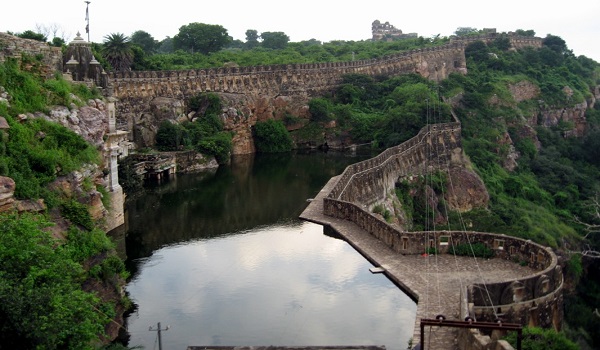
The Seven Gates
All the gates were built for security purposes and not surprisingly, the gates have special architectural designs. The gates have pointed arches, to make sure it provides extra protection should there be an attack. Notched parapets were built on top of the gates, enabling soldiers to shoot arrows at the enemy army. There is a common road that runs inside the fort, connecting all the gates. The gates, in turn lead to various palaces and temples within the fort. All the gates have historical significances. Prince Bagh Singh was killed at the Padan Gate during one of the sieges in the year 1535 AD. During the last siege, led by Emperor Akbar, Rao Jaimal of Badnore was allegedly killed by the Mughal emperor himself. This incident is said to have taken place somewhere in between the Bhairon Gate and Hanuman Gate.
Architecture
All the seven gates of the fort are nothing but massive stone structures, aimed at providing maximum security from the potential threat of enemies. The entire fort is built in such a way that it makes it almost impregnable for the enemies to enter. To ascend the fort, one has to go through a difficult path, which itself proves that the architectural design of the fort was aimed at keeping the enemies at bay. This is one of the main reasons why the fort was sieged by various kings at regular intervals. In between the second and the third gate there are two Chhatris or cenotaphs, built in honor of Jaimull and Patta, the heroes of 1568 AD when the fort was sieged by Emperor Akbar. These cenotaphs are considered as architectural marvels. The tower of the fort is nine storeyed and is adorned with sculptures of Hindu deities and stories from the Ramayana and the Mahabharata. The tower provides a breathtaking view of the city.
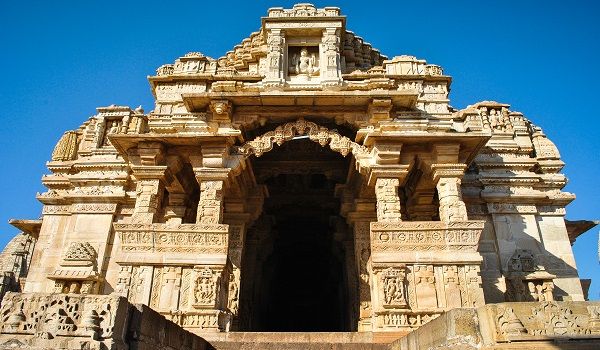
Architecture of Palaces
The palace of Rana Kumbha was built using plastered stone. One of the main features of this palace is its series of canopied balconies. Suraj Gate leads to the entrance of this palace, which is associated with a host of legends. Padmini’s palace is an impressive edifice with three storeys. The old palace, which was ruined due to various reasons, was reconstructed in the early 19th century. The building, as it stands today, is white in color. The architectural design of the old palace was a nice blend of Rajput and Mughal architecture.



